




 [Radtour Nord1]
[Radtour Nord1]
Dorsten's History - Staion 45 St Matthew
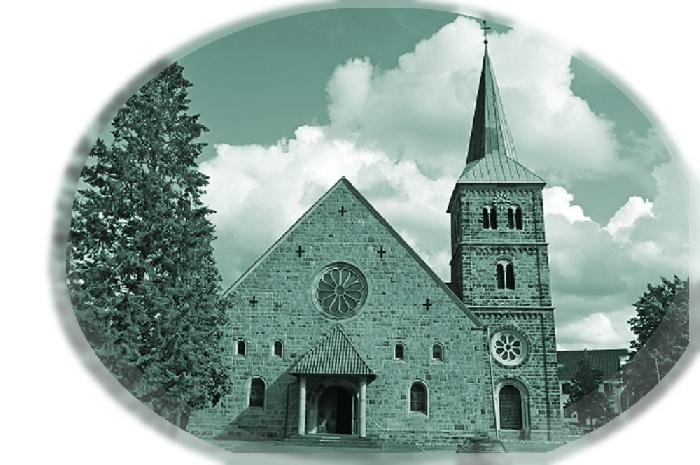
During the process of the excavations for the new history station, "St Matthew" ("St. Matthäus"), several bone parts were discovered in the last few days, as a member of the St Matthew's (St Matthäus") Parish Council confirmed on being asked about it on Friday evening. The place where they were found is by the side entrance of the church.
The alerted police detectives examined the site thoroughly, taking the bone parts with them for investigation. According to the information of our newspaper, the bones are part of a human lower leg. However, the site has been re-made accessible by the detectives for a long time, now.
An old graveyard or a crime?
Hence, it is to be assumed that the findings of the skeleton parts have to do with an old burial place. Older residents of Wulfen can remember that there was a graveyard at this site in former times.
According to "Wulfen-Wiki" the oldest Christian graveyard was situated on the area around the church for centuries, as was the custom in those times. In 1818, the regional council of Münster decreed that new burial places had to be created in areas outside of built-up areas.
The bones, which the municipal employees discovered during the excavation, must be from that graveyard and have remained undiscovered up until now. The groundwork for the history station can continue, it is said. On the 22nd March, it should be officially presented. (Dorsten's Local Newspaper "Dorstener Zeitung")
As a consequence of the Pandemic crisis, the presentation has delayed. The glass presentation plaque was stored somewhere in a garage. Just an empty steel-frame in front of the church, was a reminder.
The Station has been opend with the "Patronatnatsfest" on 26 of September 2020.
|
Frederick Barbarossa (Frederick 1), is the Holy Roman Emperor (1155-1190)
| _ |
um 1173 |
_ |
The rulers of the main court of Wulfhem are named "von Wulfheim" Drosten the Bishops Ludwig and Hermann II of Münster. (Die Herren des Haupthofs Wulfhem sind unter dem Namen „von Wulfheim” Drosten der Bischöfe Ludwig und Hermann Il. von Münster. ) Known as such, they erect their own stone church on their episcopal vassal fief ("Dienstmannslehen"). Nowadays, the street names "Burghof" and "Burgring" (Castle Court and Castle Circle) are a reminder of the previous location of the court. (Translator's Note: Explanation of the terminolgies: "Dienstmann" was used in historical times to denote a man who paid money or did service for his lord = English word "vassal". "Lehen" was the land that vassals received for their army service for their lord = English word "fief") |
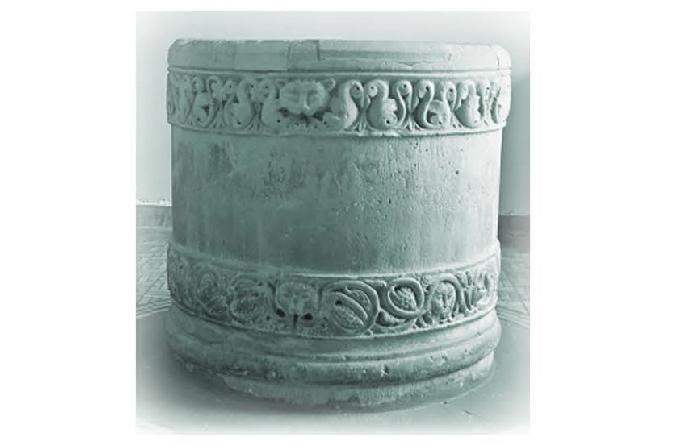 13th Century Baptismal Romanesque Font |
1280 |
_ |
Wulfen is described, for the first time, as an independent parish in a document of the Cistercian Monastery "Marienborn (Hohe Mark)". The monastery was founded in 1243 and moved to Coesfeld in 1243. | |
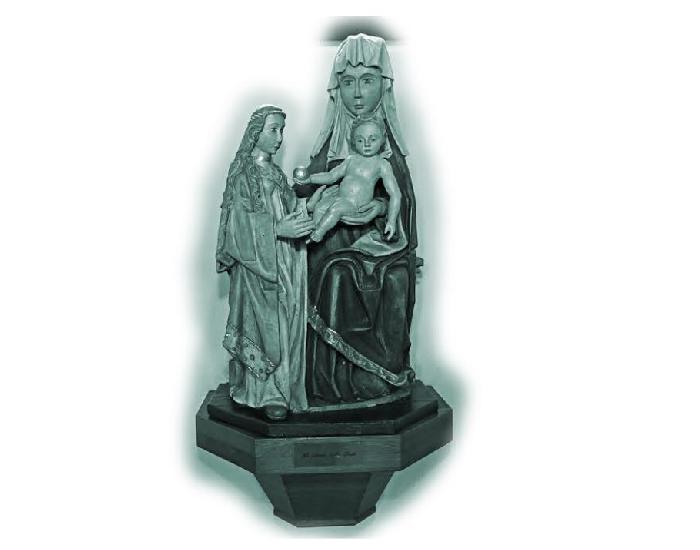 Anne Selbdritt, circa 1450 |
um 1419 |
_ |
The first extension: The nave of the church is extended by two bays and a tower. | |
|
|
1533 |
_ |
A document reports about the altar of the "hilgen Moder sunte Annen in de Kerke to Wulphen" (Translator's (humorous) Note: This phrase is not in modern day German but could mean "Holy Mother Saint Anne in the Church of Wulfen - however, "Moder", nowadays means mustiness, "sunte" seems Latin, Kerke is probably Dutch and "to" is definitely English!) | |
|
|
1554 - 1720 |
_ |
Calvinist reforming priests are appointed to join the rulers of Westerholt at "House Lembeck" ("Haus Lembeck"). The restoral of Catholicism is achieved by the priest "Pfarrer Woldering" (1672 - 1720). The chuch registers have been preserved since the middle of the 17th century. There were 120 families with around 700 inhabitants living in Wulfen in 1700. | |
|
King Frederick the Great, Frederick II of Prussia marched into Bohemia and started the Second Silesian War against the Austrian Archduchess (
| _ |
1744 - 1775 |
_ |
Second Extension: The church is extended to the East and gains a new choirstall. The church tower is increased in height by 4.5 metres in 1775 and given a Baroque dome. |
|
The Catholic Church permits the circulation of the heliocentric conception of the world
| _ |
1822 - 1825 |
_ |
Third extension: The Gothic nave has to be demolished because of dilapidation. A new 5-metre-wide nave is erected with a stone sun-dial, still to be found on the southern side of the choirstall, |
|
|
1853 - 1858 |
_ |
During a big fire, the church tower is completely burnt. Eleven houses in the direct neighbourhood are also destroyed, the nave and the choirstall of the church slightly damaged. The church tower is re-built in its present-day Neo-Romanesque form. | |
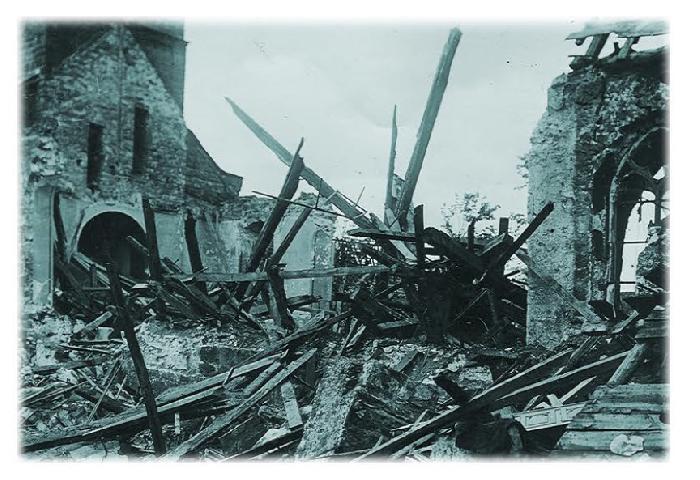 Bombing on 22nd March 1945 |
1945 |
_ |
During the bombings on the 22nd March a large part of the centre of the village is destroyed. 23 people lose their lives. Three bomb strikes destroy the nave of the church. Tower and choirstall remain with slight damage. | |
|
On the 17th June there is an Uprising in the German Democratic Republic (GDR)
| _ |
1953 |
_ |
The newly-constructed Parish Church, built following the plans of the Münster architect, Prof. Bernd Köster on the North side of the destroyed nave, is officially opened/consecrated by the suffragan/auxilliary bishop, Heinrich Baaken. |
|
|
1966 - 1987 |
_ |
Following the liturgy reform of the Second Vatican Council, the chancel, South portal, baptistry, and windows of the church are newly structured by the Priest, "Pfarrer Karl Pilatus" and in accordance with the plans and works respectively of the sculptor, Heinrich Gerhard Bücker. | |

|
2014 |
_ |
The reduction in church attendance and activity, causes the diocese of Münster to merger the church of St Matthews in Old-Wulfen ("St Matthäus in Alt-Wulfen") with the establishments "Heart of Jesus" ("Herz Jesu") in Deuten and St Barbara in Barkenberg. The church becomes part of the new church diocese of St Matthew (St Matthäus) on 24th August. |
[zurück]
Daten und Fakten
Eröffnung - Opening after the Crisis
Adresse - Side entrance of the church "Matthäuskirche"
Geodaten - 51°43'18 7°00'52.85
Feierliche Eröffnung am 26. September 2020
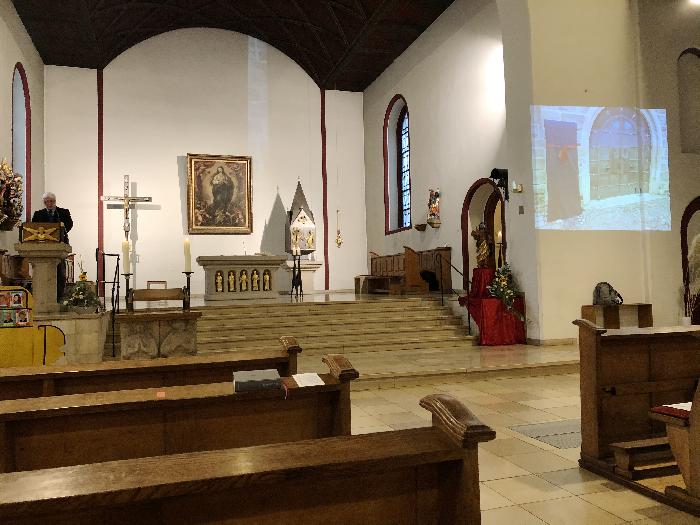
Gottesdienst zur Eröffnung
Die Einweihung der Geschichtsstation fand aufgrund der Corona-Pandemie nur mit wenigen Gästen statt. Eine ursprünglich im März geplante größere Feier musste deswegen ausfallen.
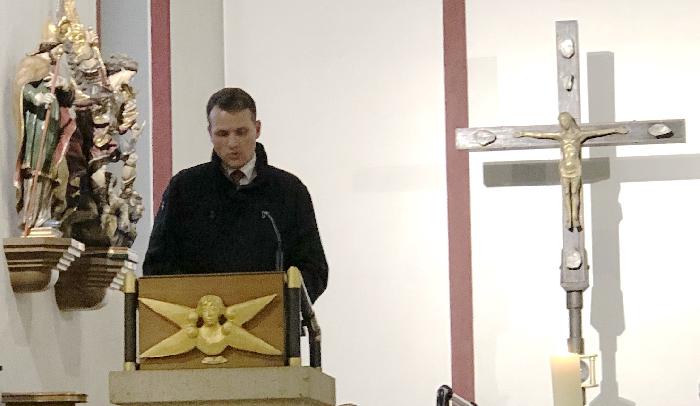
Festrede des Bürgermeisters
Gleichzeitig mit der Eröffnung der Geschichtsstation fand auch das Pfarrfest der Gemeinde St. Matthäus statt, das in der abendlichen Messe gefeiert wurde.
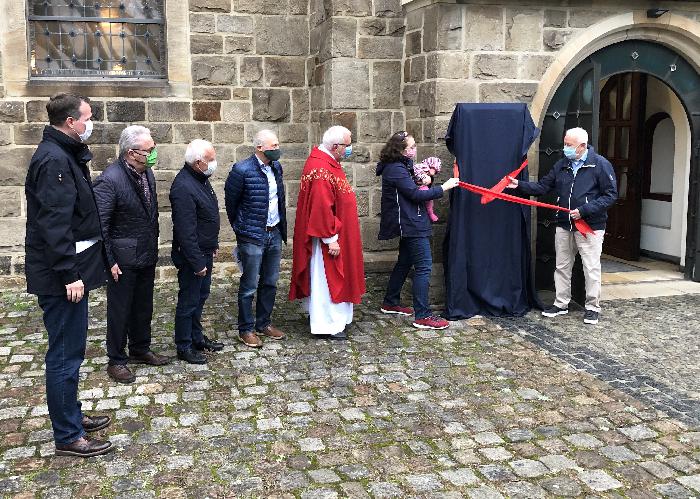
Jung und Alt enthüllten die Tafel.
Die jüngste und der älteste anwesende Kirchgänger durften dann die Geschichtsstation offiziell enthüllen.
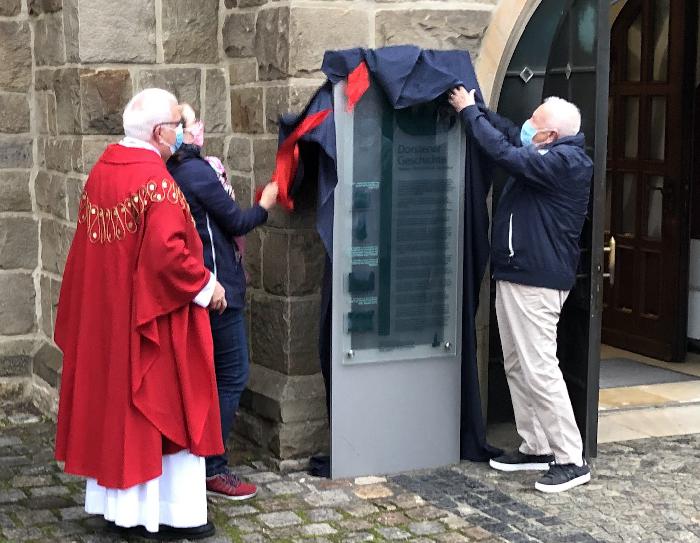
Die neue Geschichtstafel
Die 16 Woche alte Aurelia Hampe mit Mutter Mareike und Engelbert Pelz (85) lösten gemeinsam die Schleife und nahmen das Tuch ab.
Knochenfunde
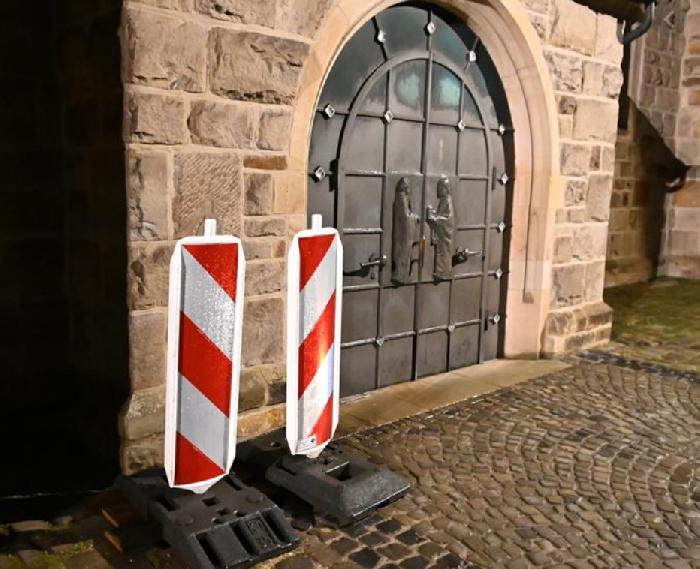
Alter Friedhof oder Verbrechen?
Im Zuge der Erdarbeiten für das Fundament der neuen Geschichtsstation wurden menschliche Skelettteile
entdeckt. Die alarmierte Kriminalpolizei untersuchte die Fundstelle genau, die Beamten nahmen die
Knochenteile zwecks Ermittlung mit. Die Vorarbeiten für die Geschichtsstation konnten nach wenigen Tagen
weitergehen.
Ältere Wulfener können sich noch erinnern, dass es an dieser Stelle in früheren Zeiten einen Friedhof
gegeben habe. Deswegen sei zu vermuten, dass es sich bei den Funden um Skelettteile aus einer alten
Begräbnisstätte handelt.

